
1️⃣ Introduction
Welcome to todays ruleset, the Little League!
Since the curation team ignores my submissions like an alarm clock on a sunday, I will be hitting snooze this time.
Big shout-out to every soul who took a moment to read, toss an upvote, or write a comment in the past, Farewell, I am off to STEM - Chris "Your mana is more frugal than a squirrel saving nuts for winter." Ah, the Little League… where mana doesn't grow on trees and utilizing Dr. Blight is becoming a necessity to even stand a chance. We will start with a glimpse into the concepts of core- and adjusted value of cards, discuss strategies for team building and counter options, showcase a ruleset-specific tier list, and finish off with a extensive review of a winning ranked battle. Every Card has a Core Value as absolute constant. No strings attached, no rules, no opponents, just the raw strength of the card, valued in Mana. Think of it like a imaginary scale from - ∞ to + ∞, where the average strength of all existing cards is defined at 0. In short: But, you don’t walk into a battle with just the Core Value and win. You need the Adjusted Value Remember, your job is to see past the price tag (the mana cost) and see the product (the actual value). Breakdown Example: A match with no rulesets, no restricted Splinter and 40 Mana Cap was found and resulted in a Adjusted Value factor of 1. Core Value = Adjusted Value = 11 Mana. A match with two rulesets Lost Magic and Healed Out as well as two available Splinter Fire and Water was found. The available Splinter suggested a very high probability to oppose a Yodin team. Baakjira's Adjusted Value Factor was determined at 0.2: Section 2 is part of a potential upcoming, more detailed post, maybe? The Kings and Queens of Little League Next, we put theory to practice, looking for synergies and avoiding dysergies. We will focus our attention to the topic of this post, the Little League ruleset. While considering card choices, the Core Value comes in handy to rank their viability and improves your decision making during team selection. A clear result of that can be seen below, where 2 or 3 mana cost units can have way more value than 4 mana units. To give some guidance, I have created a tier list as a basic overview of the best cards based on their utility and strength in Little League. Everything is based on max Level usage, this will differ in each league. Little League: The "Good-Enough-For-Rank-1" Tierlist - A Quick Overview, Not a Bible Please be aware that this is my chosen Top 5 of each Splinter, and would be considered as the best of S-Tier, ordered in viability ⬆️. This section will spotlight a unique case and briefly explain the cards used, the decisions made and puts theory in action. The battle was recorded in Champion I and ended at 4151 rating. The "Little League" rule is where we bring the little guys off the bench, this requires no further introduction. Then there's the "Equal Opportunity" rule, which morphs every unit into a potential sniper with the enemy's weakest (HP) as their target. This allows melee attackers to attack from any position as well. Lastly, a recent addition, the "Are You Not Entertained?" rule, allowing an extra Gladiator Card to be used. There are some key points to consider here: 1 - High-damage melee attackers will now attack from every position and likely be used in protected spots. 2 - Team Buffs are overpowered in Little League. Any stat buff is a +6 overall base-stat increase - multiplied by the count of buffs - diminishing in value as monsters die. This is way more valuable when you are restricted to low base-stat units. 3 - Reflection Abilities are overpowered in Little League. Refer to "Saakjora" as an example of what occurs when you choose a monster for a battle, making them as valuable as a dodo in a flying contest. 4 - The gladiator ruleset can largely be ignored in Diamond and Champion League, since almost nobody has leveled up versions, strong enough to be considered an option. 404 - Opportunity can and will be set up in a way that stacks Martyr (or Redemption) buffs on one or two Carry's, always consider facing Doctor Blight and Xenith Monk on steroids. "Why do I hear boss music?" First off, we use Tarsa as our summoner of choice. In the low base stat environment of Little League, Tarsa's + 1 HP and + 1 Attack buffs bring tremendous value. Since Tarsa is usually too weak to use at a high Elo, this is the rare niche in which she can show off her potential. Next up, in our first position sits a new, un-maxed soul bound monster in use, the Clockwork Aide. Currently, it's still in a testing phase, but this card seems promising as a valuable team-buffing sacrifice. It blocks anything physical that doesn't poison, providing the perfect boost for two of our scavengers in the lineup. In the second position, we have the Antoid Platoon. Known for being one of the best physical blocking scavengers, he provides an exceptional replacement for Xenith Monk's, or as an addition in a sleeping secondary position behind the Monk. Speaking of Xenith Monk, he holds the third position. Essential for countering Magic-Spam attacks, he also serves as an insta-win if there is no affliction on the field and the total damage is equal or less than his healing as long as he is alive somewhere. The fourth position is held by the Exploding Rats. This card fully exploits the Opportunity ruleset by spreading at least one high-damage blast attack and one redemption, potentially living another round and usually indicating that you already won the battle. Furthermore, it boosts the two Scavengers and is used as sacrifice. At the fifth position, we find the Tower Griffin. This card is a sturdy armor-spreading... basic card with one ability. But, offering incredible value! The armored effect is so good, that you can use him most of the time in Little League. He is only replaced (or supplemented) in Death teams by the Ravenhood Warden, who, apart from being vulnerable to Earthquakes, adds an inspiration buff and Mycelia in Earth teams. Finally, in the sixth position, we find Doctor Blight. Blight is the final boss, he is literally the endgame. The top banana, the big cheese, the true King Kong of the card jungle, he has every ability you could need in this format. He is that card that is not easily taken down, since you can't even hit it. And if you can, he's probably at 14 HP or you cheated with Scattershot and Magic Reflect. Unless you are facing immunity monsters, which are practically nonexistent in Little League, he is always de-buffing, team-buffing and self-buffing his HP. Always use it, always plan against it. Doctor Blight has solidified his reputation as the top card in this ruleset to such an extent, he earned a PhD without ever stepping foot in a university. With that being said, let's finish with a video of the battle:
Related posts were edited by CRISPR-Saakjora9.
☯️ The Little League Manifesto ☯️

- Splinterlands, Chris' edition
2️⃣ Chris' Card Calculus™️
Distinguishing between Core Value and Adjusted Value
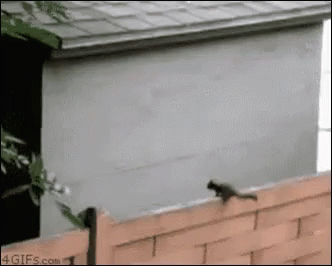
The first time calculating the Adjusted Value of a card in a real match
# Variables
MC = Real "Mana Cost"
MV = Determined "Mana Value"
CV = "Core Value"
# Calculating the Core Value
CV = MC - MV
A number you compute, factoring in the rulesets, usable splinter, mana cap, lineup history, in addition to predetermined factors like your own card collection and experience.
Baakjira is a 6 mana monster, determined to have a Core Value of 11 Mana.
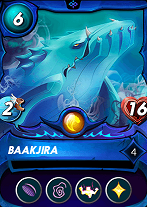
Healthy Baakjira with +5 Mana valuation.
💔 His Heal was removed
❌ His Void has no use
💢 Yodin as most likely opponent is a hard-counter
The result: A Adjusted Value of 11 Mana * 0.2 = 2.75 Mana, translates to a -3.25 Mana valuation
[Image: ©️chrisheyne]
Escaped Baakjira, now posing as "Saakjora". Don't use Baakjira with a negative valuation, that's hard to accomplish.
3️⃣ Teambuilding
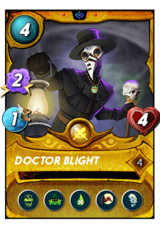
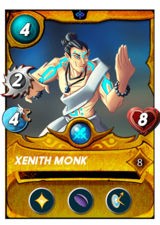
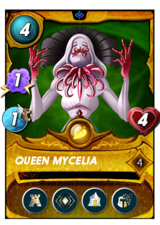
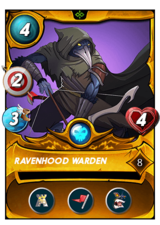
Summoners Neutral Dragon Fire Water Earth Life Death Lorna Shine(3) Doctor Blight 👑(4) Vruz(2) Spark Pixies(4) Feasting Seaweed(4) Queen Mycelia💛(4) Time Mage(4) Ravenhood Warden🖤(4) Kelya Frendul(4) Xenith Monk ⚜️(4) Dhampir Infiltrator(4) Antoid Platoon(4) Tortisian Fighter(4) Failed Summoner(2) Truthspeaker(3) Riftwing(4) Thaddius Brood(4) Tower Griffin (4) Naga Assassin(2) Scavo Firebolt(4) Kelp Initiate(2) Acid Shooter(2) Pelacor Conjurer(2) Venari Bonesmith(4) Mylor Crowling(3) Elven Mystic(4) Twilight Basilisk(4) Serpentine Spy(3) Igor Darkspear(2) Khmer Princess(2) Crystal Jaguar(4) Soul Strangler(3) Quix The Devious(4) Grenadier(3) Kra'ar Xoc(1) Flame Monkey(1) Coral Wraith(4) Fungus Flinger(3) Venari Crystalsmith(4) Weirding Warrior(2)
Bold names indicate higher strength, which would be considered S+-Tier and includes their mana-cost - shown in parenthesis.
Additional formatting ⚜️ are crowned, broken units in their role, probably the Chuck-Norris Tier.
4️⃣ Battle Analysis: The Little League Showdown
Click me to get to the battle replay
The Rules.



Same reason as (3): Always consider using reflection abilities on your tanks (or choose Mylor) and combine it with Amplify, as well as Reflection Shield for the safety of your own attacking monsters.
Little League restricts broken cards such as Quora as well.
The Team.
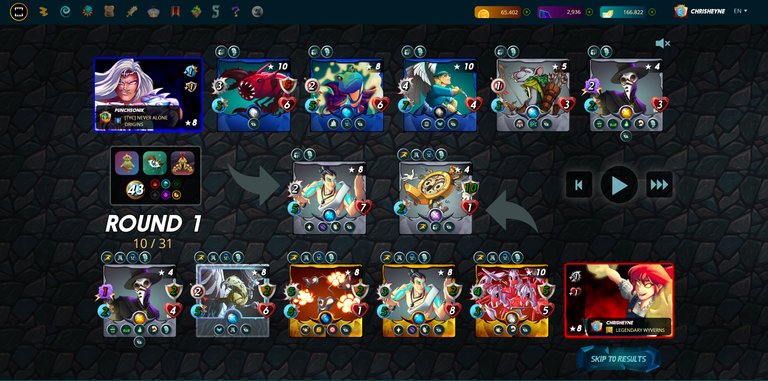
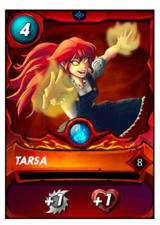


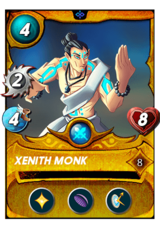
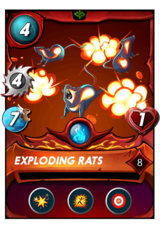
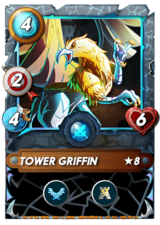
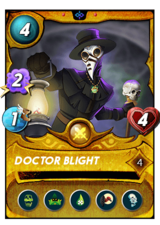
In your browser, rename the ruleset to "Little Blight's League" as a testament to his dominance.


